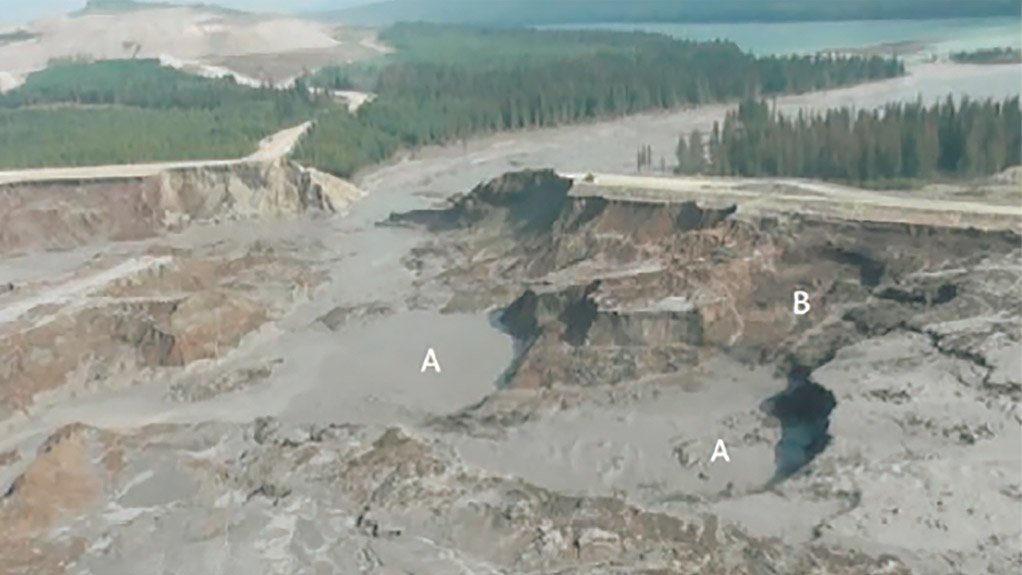Efforts towards preventing future tailings dam failures
Giving back to the engineering community by sharing experiences and research on tailings dam safety and failures is crucial to the further understanding of this issue, which is highly pertinent to the mining sector, says Jones & Wagener engineering and environmental consultants (J&W), Waste and Tailings technical director and award-winning engineer Danie Brink.
Together with fellow engineer J&W director and Waste and Tailings department head Dr Martin Rust, Brink recently presented the company’s findings on lessons learnt from tailings failures at a workshop hosted by the South African Institution of Civil Engineering (SAICE).
“South Africa’s tailings dams are generally well designed, even though many of them are in their twilight years, they still require proper management to prevent tailings failures and the resulting damage to the environment, property and possibly life.
“A new global requirement is coming into play that necessitates dams to be regularly and correctly assessed so as to prevent reoccurrence of massive disasters such as the Samarco Fundão dam mudslide tragedy of 2015,” said Rust.
This mudslide left 19 people dead and caused major environmental damage and river pollution. As a result of this disaster, the monitoring of changes to the original dam design, water levels and any change to the drainage function becomes a critical activity.
“We at J&W believe our Waste and Tailings department offers world-class consultants available for dam assessment, owing to our expertise and experience in this sector. We are the ‘Engineer of Record’ and, therefore, are legally accountable for the tailings dams we currently assess and conduct surveillance on for our clients.”
The department offers:
- Assessment and costing of disposal alternatives;
- Feasibility studies;
- Waste classification;
- Design of tailings disposal facilities;
- Dam surveillance and auditing;
- Geotechnical, geohydrological and hydrological investigations;
- Dam rehabilitation;
- Non-Newtonian dam break assessments;
- Project management and construction supervision;
- Water and salt-balance monitoring;
- Environmental approvals and licensing (and associated specialist investigations where appropriate);
- Design and implementation of remediation, capping and closure measures; and
- Dam safety evaluations.
Methodologies and concepts currently used for tailings assessments include effective stress and undrained stability analyses, liquefaction potential analyses, discharge prediction and dam break simulation. The use of precise instrumentation, such as the friction Piezocone, supplies data through penetration testing for cone resistance, sleeve friction, dynamic pore pressure and enables soil behaviour type profiling. Dissipation tests for static pore pressure and rates of dissipation are also conducted.
“The Piezocone is our instrument of choice for measurement because of the vast amount of data it can capture, analyse and measure, enabling us to obtain information regarding the state of the dam tailings,” said Rust.
However, he noted that there are numerous triggers that could cause dam failure that “we need to be aware of and explore to further reinforce our assessment” of a tailings dam’s stability.
Potential triggers include localised slope failure, foundation failure, undermining collapse, seismic activity and undrained failure, owing to a high rate of loading. The mismanagement of tailings dams can lead to overtopping, piping, progressive sloughing causing over steepening, rathole development and collapse. Similarly, erosion progressing unchecked and inadequate vegetation control can lead to loss of integrity of the outer walls, with Rust questioning how many of these factors were accounted for in the stability analysis and the relevance of the effective stress analysis if contractive materials are present?
J&W’s experience indicates that the reduction of water storage at tailings storage facilities is probably the most important and achievable intervention for high-risk facilities. Credible failure modes should be classified in terms of tailings state and pond location, while the potential discharge volume should be based on this classification.
“In South Africa, dams are normally constructed as upstream facilities. We are probably the only country in the world that focuses on rate-of-rise coupled with climatic conditions in our dam management, but we need to keep abreast of the critical triggers and updated methodologies available to us. We also need to plan for more regular and thorough assessments of our dams. We cannot leave them unmaintained and unmanaged purely based on the age of the dam and budgetary constraints.
“J&W’s team of professional engineers and scientists can and do play an important role in tailings failure investigations and assessments. We have significant in-depth knowledge and experience to bring to the table. We take the safety element of tailings management very seriously, owing to the extreme ramifications of what could happen if we did not,” Rust said.
Learning from the Past
Brink presented three case studies at the SAICE workshop comprising well-documented tailings failures – Merriespruit, in the Free State, South Africa; Mount Polley, in British Columbia, Canada; and the Fundão dam at the Samarco mine, in Brazil.
“All three tailings dam failures caused havoc in one way or another. Merriespruit reported 17 deaths with 600 000 m3 of liquefied tailings flowing through the town, while the Fundão dam failure reported 19 fatalities and 60-million metres cubed of iron-ore tailings flowing into the Doce river, with the mudflow reaching the Atlantic ocean 600 km downstream, 17 days later. The Mount Polley dam breach caused 11-million m3 of water and 4.5-million m3 of slurry to flow out of the 150-m-wide breach into the Polley lake, which also affected two further lakes downstream,” illustrated Brink.
It is ironic that the Merriespruit dam, he said, had been abandoned 15 months prior to the failure, therefore, quite clearly supporting the theory of the need to conduct regular dam assessments whether the dam is operational or not. “Many factors came into play when the sudden and heavy downfall of rain led to overtopping and the subsequent failure. Attention to operational and management issues, such as freeboard and pool management, design concepts, water balance and regular surveillance, all play a part in preventing failures at dams.”
Brink further stated that the Fundão dam disaster highlighted issues such as the failure of the basal drainage system and drainage galleries; the change in process resulting in a different composition of coarse sand material, compared with a finer slime material; the introduction of slime into the sand zone through the by-pass channel and the setback of the left abutment. “This dam also had a very high rate of rise – 3 m in the month prior to failure. That is an unusually high rate of rise,” he commented.
The panel of experts who conducted the investigation into the Fundão failure reported that within 75 m of the dam crest about 70% to 80% of the sand tailings were indicated to have been contractive. The bulk of the body of sand tailings was saturated. Static liquefaction of the sand tailings was triggered by the lateral extrusion of the soft slimes underlying the sand tailings. Owing to this movement, the sand immediately above the slime experienced a reduction in the vertical stress that confined it and became looser.
The impact of previous seismic activity could have induced displacements, which likely accelerated the failure process that was already well advanced.
Brink added: “The Mount Polley tailings failure, which was sudden and without warning, put issues, such as human intervention, overtopping, piping and cracking and foundation failure, in the spotlight”.
Lessons learnt from the three case studies discussed during the presentation include the fact that:
- Undrained failures may be triggered through a variety of mechanisms
- Geotechnical investigations are often inadequate;
- Lack of proper water management is a common denominator in most failures and often dominates the consequences of a failure; and
- Engineering teams can become caught up in the “production at all cost” trap – thereby becoming part of the problem often resulting in changes from the original design intent not being assessed adequately.
“Hindsight is a wonderful thing.” said Brink. “We learn from the findings of investigations. They enable us to question whether our procedures can be improved and sharpened. They flag issues that, with better understanding and assessment, can prevent these kinds of disasters going forward.”
The Future is Quality Assessment and Management
Rust said the experience of South African engineers was without question. “We pioneered identification methods, technologies and processes on tailings dams. We are good at tailings dam management in South Africa, but improved modern investigation and analysis tools enable us to up our game further. There is room to use this greater body of knowledge and available instrumentation practically and efficiently to enhance the safety of dams and the communities that surround them.”
The Waste and Tailings team at J&W is an experienced team that takes cognisance of international developments in tailings management and measurement, emphasised Rust. “The level of surveillance required is dependent on the risk posed by a particular facility. Surveillance must be based on accurate and appropriate data, supported by regular visual assessments. At the very outset, we recommend an inspection every three months to ensure safety of the dam to the environment and the livelihoods of those working and residing in these areas.
“At the end of the day, we are accountable and responsible; we are professionals and experienced in the field of tailings facility designs and management.” That is who J&W is,” he concluded.
Comments
Press Office
Announcements
What's On
Subscribe to improve your user experience...
Option 1 (equivalent of R125 a month):
Receive a weekly copy of Creamer Media's Engineering News & Mining Weekly magazine
(print copy for those in South Africa and e-magazine for those outside of South Africa)
Receive daily email newsletters
Access to full search results
Access archive of magazine back copies
Access to Projects in Progress
Access to ONE Research Report of your choice in PDF format
Option 2 (equivalent of R375 a month):
All benefits from Option 1
PLUS
Access to Creamer Media's Research Channel Africa for ALL Research Reports, in PDF format, on various industrial and mining sectors
including Electricity; Water; Energy Transition; Hydrogen; Roads, Rail and Ports; Coal; Gold; Platinum; Battery Metals; etc.
Already a subscriber?
Forgotten your password?
Receive weekly copy of Creamer Media's Engineering News & Mining Weekly magazine (print copy for those in South Africa and e-magazine for those outside of South Africa)
➕
Recieve daily email newsletters
➕
Access to full search results
➕
Access archive of magazine back copies
➕
Access to Projects in Progress
➕
Access to ONE Research Report of your choice in PDF format
RESEARCH CHANNEL AFRICA
R4500 (equivalent of R375 a month)
SUBSCRIBEAll benefits from Option 1
➕
Access to Creamer Media's Research Channel Africa for ALL Research Reports on various industrial and mining sectors, in PDF format, including on:
Electricity
➕
Water
➕
Energy Transition
➕
Hydrogen
➕
Roads, Rail and Ports
➕
Coal
➕
Gold
➕
Platinum
➕
Battery Metals
➕
etc.
Receive all benefits from Option 1 or Option 2 delivered to numerous people at your company
➕
Multiple User names and Passwords for simultaneous log-ins
➕
Intranet integration access to all in your organisation























